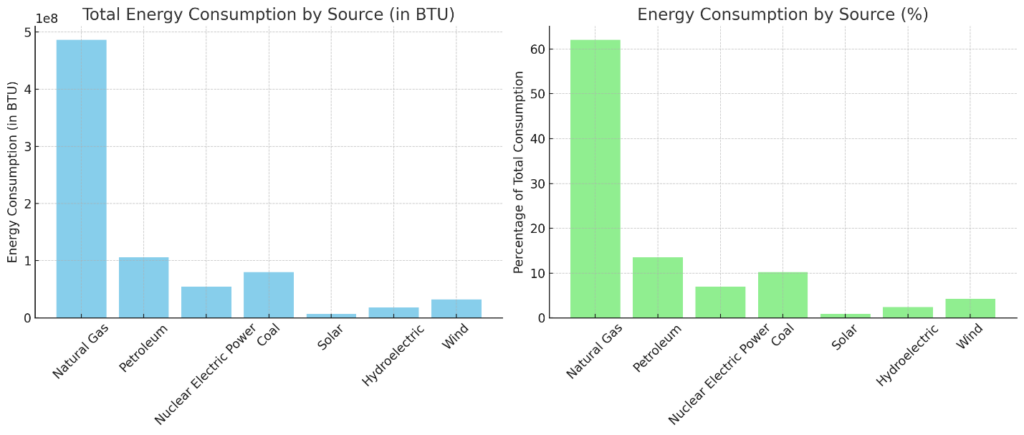Natural Gas Has Become the Indispensable Energy Source
The week of January 13-19 saw extreme cold and winter storms across much of the country. Natural gas made up 62% of all the energy delivered across the United States economy during that week. This calculation takes into account the direct use of natural gas for home heating, all energy used for electrical generation and all fuel. That week’s energy use by source is visualized below in BTU and percentage terms.

There are numerous reasons why natural gas has quickly become the indispensable energy source for America’s energy system.
Natural gas is easy to store. Batteries are a great form of energy storage for periods of up to four hours. However, even the best batteries bleed energy over time. Natural gas can be kept almost indefinitely in underground storage, places like salt caverns and depleted aquifers. This matters because energy demand is seasonal, peaking in the summer from air conditioning demands and the winter due to heating requirements. In between those peaks is what is known as the “shoulder season,” when excess natural gas can be injected into storage for later use. That means that natural gas is dispatchable.
A solar panel produces energy when the sun is shining on it and in accordance with how direct that sunlight is. You can’t tell the solar panel to produce more – as an intermittent energy source, you get what you get, when you get it. This is useful for summer peak demand, as high air conditioning demand during the day frequently coincides with sunny days and high solar energy production. For long, cold winter nights and the overcast conditions of a winter storm, it leaves something to be desired. This is where the dispatchable nature of natural gas shines. Natural gas power plants can ramp up and down to meet demand as the weather cools. Dispatchable energy is there when you need it most.
Ensuring that customers can afford to heat their homes is often as important as making sure the energy to do so is physically available. According to the IEA, natural gas is 3.3 times as affordable as electricity. The average family that heats with natural gas saves $1,132 per year compared to an all-electric household.
Natural gas is affordable. That affordability means that millions of people who might struggle to afford an electric heating bill can sleep well knowing they can afford to stay warm. Natural gas utilities work to expand on the natural affordability of natural gas with programs to assist low-income households.
AGA member companies spend an average of $4.3 million each day on programs that help customers weatherize their homes and buy more efficient appliances, saving them money while lowering emissions. Additionally, programs like LIHEAP (the Low-Income Household Energy Assistance Program) help low-income customers directly pay for their energy bills. Increasing funding to LIHEAP is a major priority for AGA and our industry as part of ongoing efforts to break the cycle of energy poverty.
The final reason that natural gas was responsible for almost 2/3 of the energy delivered during the recent winter storms? Natural gas is reliable.
You likely didn’t see much coverage about the record-breaking demand for natural gas. This is because the natural gas delivery system functioned extremely well, delivering natural gas where it was needed, when it was needed, all while breaking records for the most natural gas delivered in a single day. Unplanned outages of natural gas are 1/650th as common as unplanned electrical outages. On the coldest days of the year, this reliability saves lives. Reliability is a major reason why natural gas has come to underpin the entire energy system.